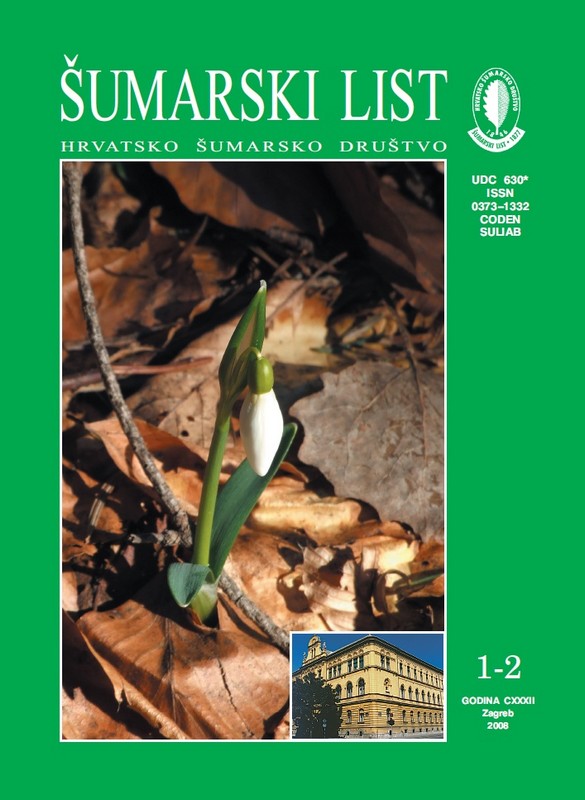
broj: 1-2/2008
pdf (26,3 MB) |
|
||||||||||||||
| IZVORNI ZNANSTVENI ČLANCI | ||
| Oršanić, M., D. Horvat, N. Pernar, M. Šušnjar, D. Bakšić, D. Drvodelić | UDK 630* 232.3 + 181.4 (001) | |
| Influence of Mineral and Bio Oil on the Germination of Acorn and the Growth of Pedunculate Oak (Quercus Robur L.) Seedlings pdf HR EN | 3 | |
| Meštrović, Augustin | UDK 630* 907 (001) | |
| Beneficial Functions of Whitebark Pine Forests (Pinus Heldreichii Christ) on the Mountain of Čvrsnica pdf HR EN | 11 | |
| Trinajstić, Ivo | UDK 630* 188 (001) | |
| Contribution to the Spreading of the Yew and Linden Forest Ass. Tilio-Taxetum Glavač 1958 In Croatia pdf HR EN | 25 | |
| Summary: In the work, the new localities of the Tilio-Taxetum ass. in Croatia are published. These are Vražji prolaz near Skrad and Kamačnik near Vrbosko in Gorski Kotar, as well as the Plitvice Lakes National Park in Mala Kapela. The floristic composition is shown in the analytical table 1, prepared on the basis of 4 relevés. Simultaneously, it was made the syntaxonomic revision of the floristic composition published by Glavač (1959: Tab. 1), prepared on the basis of 15 relevés. Within the so-far known floristic composition of the ass. Tilio-Taxetum, a total of 183 species has been registered. In all 19 relevés (100 %) 2 species only, or 1,1 %, have been registered, in more than 50 % (10–19) of the relevés 39 species, or 21,3 %, have been registered, while in one relevé only 53 species, or 29 %, of the total floristic composition have been registered. Out of the total floristic composition, 11 species, or 61,2 %, are individual syntaxa and 71 species, or 38,8 %, are companion plants. The quantitative relations of individual groups of species (characteristic and differential species, companion plants) are shown in table 1 under columns 5, 6 and 7. The Illyrian association Tilio-Taxetum is classified in the Aremonio-Fagion alliance and inside it in the Ostryo-Fagenion suballiance, the Fagetalia sylvaticae order and the Querco-Fagete class. Its congenerous Central European association Taxo-Fagetum is classified within the Fagetalia sylvaticae order and the class Quereco-Fagetea class in the Fagion sylvaticae alliance and the Cephalanthero-Fagenion suballiance. From the syndynamic and syngenetic point of view, the initial and optimal development phases of the Tilio-Taxetum ass., because of their growing on steeper slopes, are reflected as a constant stage within the climazonal beech forests. The terminal development phase shows a tendency of succession toward the climazonal forms of beech or beech-fir forests. In the first case it is mostly the. Ostryo-Fagetum ass., and in the second case probably the Omphalodo-Fagetum ass. | ||
| PREGLEDNI ČLANCI | ||
| Martinić, I., M. Kosović, I. Grginčić | UDK 630* 907.2 | |
| Outdoor Activities and Visitor Risk Management in Protected Areas pdf HR EN | 33 | |
| STRUČNI ČLANCI | ||
| Mayer, Ž., Ž. Hećimović | UDK 630* 263 + 231 | |
| Regeneration of Floodplain Forests in the Croatian Podunavlje Region Combined with Planting Seedlings of Narrow-Leaved Ash (Fraxinus angustifolia Vahl.) pdf HR EN | 43 | |
| Posarić, Darko | UDK 630* 263 + 231 + 676 | |
| Regeneration of Pedunculate oak forests in Spačva by seed cutting – possibilities of improving a recent working method pdf HR EN | 53 | |


